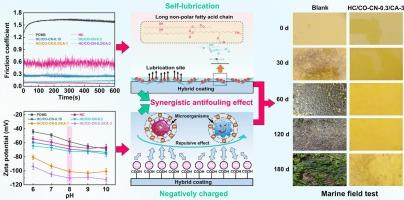Transparent hybrid coatings for marine antifouling: Synergizing amphiphilicity, nanocellulose lubrication, and electrostatic repulsion
IF 13.2
1区 工程技术
Q1 ENGINEERING, CHEMICAL
引用次数: 0
Abstract
The development of environmentally compliant marine antifouling coatings requires innovative strategies that transcend conventional biocide-dependent approaches. We present a transparent silicone-based hybrid coating integrating amphiphilic telomers, castor oil-modified cellulose nanocrystals (CO-CNs), and cholic acid through covalent bonding, demonstrating high transparency (>90 % transmittance) and excellent flexibility, which also demonstrates strong adhesion (~3.93 MPa) to the substrate, ensuring its use in harsh marine environments. This system achieves exceptional antifouling performance through synergistic interplay of three fundamental mechanisms: a microscale amphiphilic surface, nanocrystal-enabled lubrication (friction coefficient reduction from 0.52 to 0.08), and enhanced electrostatic repulsion (zeta potential of −110.22 mV at pH 8). The microscale hydrophobic/hydrophilic heterogeneities from amphiphilic telomers disorient microorganisms. Notably, incorporating CO-CNs creates abundant lubrication sites on the coating surface that reduce microorganism contact area. Simultaneously, cholic acid-derived carboxyl groups amplify electrostatic repulsion synergistically against negatively charged microorganisms, as verified by 98 % reduction in bacterial adhesion forces (0.29 nN vs 7.29 nN for commercial PDMS) as evidenced by fluidic force microscopy. Laboratory evaluations demonstrated 95 % inhibition of protein adsorption and 99 % reduction in diatom settlement compared to those of commercial PDMS. Furthermore, field trials in Qingdao seawater revealed sustained antifouling efficacy over 180 days, with coated surfaces maintaining >90 % macrofouling resistance through seasonal variations. The demonstrated synergy between amphiphilicity, surface lubrication, and electrostatic repulsion offers significant potential for sustainable maritime applications.

用于船舶防污的透明杂化涂料:协同两亲性、纳米纤维素润滑和静电排斥
开发符合环境要求的海洋防污涂料需要超越传统的生物杀菌剂依赖方法的创新策略。我们提出了一种透明的硅基杂化涂层,将两亲性端粒、蓖麻油修饰的纤维素纳米晶体(CO-CNs)和胆酸通过共价键结合在一起,具有高透明度(>;90 %透光率)和优异的柔韧性,同时还具有很强的附着力(~3.93 MPa),确保其在恶劣的海洋环境中使用。该系统通过三种基本机制的协同相互作用实现了卓越的防污性能:微尺度两亲性表面,纳米晶体润滑(摩擦系数从0.52降至0.08)和增强的静电斥力(zeta电位为- 110.22 mV, pH为 8)。两亲端粒的微尺度疏水/亲水非均质性使微生物迷失方向。值得注意的是,加入CO-CNs在涂层表面创造了丰富的润滑位点,减少了微生物的接触面积。同时,胆酸衍生的羧基对带负电荷的微生物协同增强静电斥力,如流体力显微镜所证实的,细菌粘附力降低了98% % (0.29 nN vs . 7.29 nN,商用PDMS)。实验室评估表明,与商业PDMS相比,蛋白质吸附抑制率为95% %,硅藻沉降降低99 %。此外,在青岛海水中进行的现场试验显示,涂层表面在180 天内保持了持续的防污效果,涂层表面在季节变化中保持了90% %的宏观污垢抗性。两亲性、表面润滑和静电斥力之间的协同作用为可持续的海事应用提供了巨大的潜力。
本文章由计算机程序翻译,如有差异,请以英文原文为准。
求助全文
约1分钟内获得全文
求助全文
来源期刊

Chemical Engineering Journal
工程技术-工程:化工
CiteScore
21.70
自引率
9.30%
发文量
6781
审稿时长
2.4 months
期刊介绍:
The Chemical Engineering Journal is an international research journal that invites contributions of original and novel fundamental research. It aims to provide an international platform for presenting original fundamental research, interpretative reviews, and discussions on new developments in chemical engineering. The journal welcomes papers that describe novel theory and its practical application, as well as those that demonstrate the transfer of techniques from other disciplines. It also welcomes reports on carefully conducted experimental work that is soundly interpreted. The main focus of the journal is on original and rigorous research results that have broad significance. The Catalysis section within the Chemical Engineering Journal focuses specifically on Experimental and Theoretical studies in the fields of heterogeneous catalysis, molecular catalysis, and biocatalysis. These studies have industrial impact on various sectors such as chemicals, energy, materials, foods, healthcare, and environmental protection.
 求助内容:
求助内容: 应助结果提醒方式:
应助结果提醒方式:


